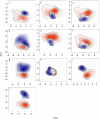Predicting the invasiveness of alpine newts in the UK
- PMID: 40078509
- PMCID: PMC11893677
- DOI: 10.1007/s10530-025-03543-2
Predicting the invasiveness of alpine newts in the UK
Abstract
Predicting invasion risk to novel environments is essential for risk management and conservation decision making but the evolutionary lineage at which to make these predictions is often unclear. Here we predict the current suitability across the United Kingdom (UK) for the alpine newt Ichthyosaura alpestris, a species with a complex evolutionary history, a broad native range, a growing number of introduced populations and anecdotal reports of ecological consequences to native amphibian communities. We use species distribution and ecological niche modelling to predict environmental suitability of the alpine newt in the UK at both the species-level and lineage-level and to quantify evolutionary lineage niche overlap. We show good model transferability at the species-level and parts of the UK-especially central and eastern England and parts of central and northern Scotland-to be highly environmentally suitable for the alpine newt. Our findings provide evidence of environmental niche differences at the lineage-level, with the Greek lineage being distinct from most other lineages, but with low confidence in maxent predictions for the Greek, Balkan and Italian lineages due to high levels of extrapolation. In contrast, the niche of the UK records appear to share the same niche as the Central lineage. We find 66% of currently known alpine newt records to fall within areas predicted to be environmentally suitable at the species-level, providing a series of testable hypotheses to better understand the invasion ecology of this species in the UK.
Supplementary information: The online version contains supplementary material available at 10.1007/s10530-025-03543-2.
Keywords: Alpine newt; Ichthyosaura alpestris; Invasive; Maxent; Niche; Species distribution modelling.
© The Author(s) 2025.
Conflict of interest statement
Conflict of interestThe authors have no relevant financial or non-financial interests to disclose.
Figures







References
-
- Allouche O, Tsoar A, Kadmon R (2006) Assessing the accuracy of species distribution models: prevalence, kappa and the true skill statistic (TSS). J Appl Ecol 43:1223–1232. 10.1111/j.1365-2664.2006.01214.x
-
- Araújo MB, Pearson RG (2005) Equilibrium of species’ distributions with climate. Ecography (Cop) 28:693–695. 10.1111/j.2005.0906-7590.04253.x
-
- Araújo MB, Peterson AT (2012) Uses and misuses of bioclimatic envelope modeling. Ecology 93:1527–1539. 10.1890/11-1930.1 - PubMed
-
- Arntzen J, Denoël M, Kuzmin S, et al (2009) Ichthyosaura alpestris. the IUCN Red List of Threatened Species 2009. In: IUCN
-
- Arntzen JW, King TM, Denoël M et al (2016) Provenance of Ichthyosaura alpestris (Caudata: Salamandridae) introductions to France and New Zealand assessed by mitochondrial DNA analysis. Herpetol J 26:49–56
LinkOut - more resources
Full Text Sources
